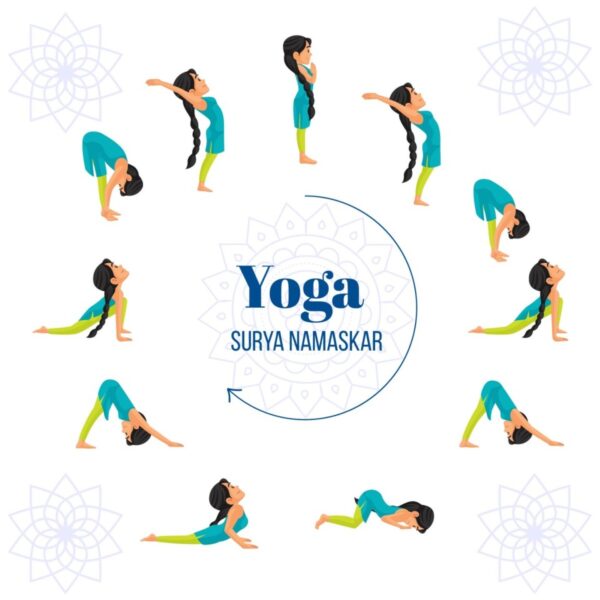Surya Namaskar is a complete workout that combines both physical and spiritual aspects. It involves a series of 12 yoga postures that are performed in a sequence, with each pose flowing into the next one. The 12 poses of Surya Namaskar are designed to activate and balance all the major muscle groups, organs, and energy centers in the body. It is a complete workout that can be performed in just a few minutes, making it a perfect addition to any busy lifestyle.

Sun Salutation is an ancient practice that has been passed down through generations. It is believed to have originated in India over 2,500 years ago and has since been widely practiced across the world. The practice of sun salutation involves a series of 12 yoga poses that are performed in a sequence, with each pose flowing into the next one. The sequence of poses is designed to activate and balance all the major muscle groups, organs, and energy centers in the body.
Step-by-step guide to Surya Namaskar
Here is a step-by-step guide to performing Surya Namaskar:
Step 1 – Pranamasana (Prayer Pose)

Stand at the front of your mat with your feet together and arms by your sides. Close your eyes, bring your palms together at the center of your chest, and relax your entire body.
Step 2 – Hasta Uttanasana (Raised Arms Pose):

Inhale deeply, stretching your arms forward and upward over your head. Look up and gently arch your body backward, pushing your pelvis forward.
Step 3 – Hasta Padasana (Hand to Foot Pose):

Exhale and fold forward from the waist, keeping your spine long. Place your hands on the floor beside your feet, bending your knees if necessary.
Step 4 – Ashwa Sanchalanasana (Equestrian Pose):

Inhale, stepping your right leg back and placing your right knee on the floor. Keep your left foot flat on the floor and look up, gently arching your back.
Step 5 – Parvatasana (Mountain Pose):

Exhale, stepping your left foot back to join your right foot, lifting your hips into an inverted V shape. Press your hands firmly into the ground and lengthen your spine.
Step 6 – Ashtanga Namaskara (Eight Limbed Salute):

Lower your knees to the floor while exhaling. Gently lower your chest and chin to the floor while keeping your hips slightly raised.
Step 7 – Bhujangasana (Cobra Pose):

Inhale, sliding your body forward and raising your chest into a cobra-like position. Keep your elbows bent and shoulders away from your ears as you gaze upwards.
Step 8 – Parvatasana (Mountain Pose):

Exhale, returning to the inverted V shape of the Mountain Pose. Focus on lengthening your spine and pressing your hands into the mat.
Step 9 – Ashwa Sanchalanasana (Equestrian Pose):

Inhale, stepping your right foot forward between your hands while lowering your left knee to the floor. Arch your back and gaze upward.
Step 10 – Hasta Padasana (Hand to Foot Pose):

Exhale, bringing your left foot forward to meet your right foot. Fold forward from the waist, placing your hands on the floor beside your feet.
Step 11 – Hasta Uttanasana (Raised Arms Pose):

Inhale, raising your arms upward over your head and gently arching your body backward. Focus on stretching and lengthening your entire body.
Step 12 – Tadasana (Mountain Pose):

Exhale, returning to the standing Mountain Pose with your feet together and arms by your sides. Relax and feel the energy circulating throughout your body.
Completing all 12 poses constitutes one cycle of Surya Namaskar. Ideally, practicing 12-15 cycles daily will provide your body with the nourishment and balance it needs for optimal health and well-being.
Benefits of Surya Namaskar
Surya Namaskar is a complete workout that can bring numerous benefits to your body, mind, and spirit. Here are some of the benefits of practicing Sun Salutation:
Improved cardiovascular health: The sequence of postures in Surya Namaskar provides a comprehensive cardiovascular workout, improving blood circulation and strengthening the heart.
Enhanced flexibility: Sun Salutation helps to stretch and strengthen the muscles, tendons, and ligaments throughout the body, promoting increased flexibility and range of motion.
Weight management: As an effective calorie-burning exercise, Surya Namaskar can assist in weight loss and weight management when practiced consistently.
Stress relief: The meditative nature of Surya Namaskar helps to calm the mind and relieve stress, promoting mental clarity and emotional balance.
Improved digestion: By stimulating the digestive system, Surya Namaskar can aid in the prevention and alleviation of digestive issues, such as constipation and indigestion.
Stronger immune system: The regular practice of Sun Salutation has been linked to improved immune function, helping to protect the body from illness and disease.
Increased energy levels: It helps to invigorate and energize the body, boosting overall vitality and stamina.
Overall well-being: Surya Namaskar is a holistic practice that can bring numerous benefits to your overall well-being. By practicing Surya Namaskar regularly, you can improve your physical health, mental clarity, and emotional balance.
The best time to practice Sun Salutation

Surya Namaskar can be practiced at any time of the day, but the best time to practice it is early in the morning, on an empty stomach. This is because practicing Surya Namaskar in the morning can help to energize your body and mind and prepare you for the day ahead. If you’re unable to practice Sun Salutation in the morning, you can also practice it in the evening, but make sure to leave a gap of at least 2-3 hours after your last meal.
Surya Namaskar for Weight Loss
In addition to its numerous health benefits, Surya Namaskar can be an effective tool for weight loss when practiced regularly and combined with a balanced diet and healthy lifestyle. The dynamic postures of Surya Namaskar help to increase metabolism and burn calories, making it an ideal addition to any weight loss regimen.
To maximize the weight loss benefits of Surya Namaskar, consider incorporating it into your daily routine, gradually increasing the number of cycles as your fitness level improves. Additionally, focus on maintaining proper form and alignment throughout each posture to ensure optimal results and prevent injury.
Conclusion
Surya Namaskar is an ancient practice that has been passed down through generations. It is a complete workout that can bring numerous benefits to your body, mind, and spirit. By practicing Surya Namaskar regularly, you can improve your flexibility, balance, strength, circulation, digestion, and overall well-being. Remember to practice Surya Namaskar early in the morning, on an empty stomach, for best results. So, why not give it a try and experience the amazing benefits of Surya Namaskar for yourself?




